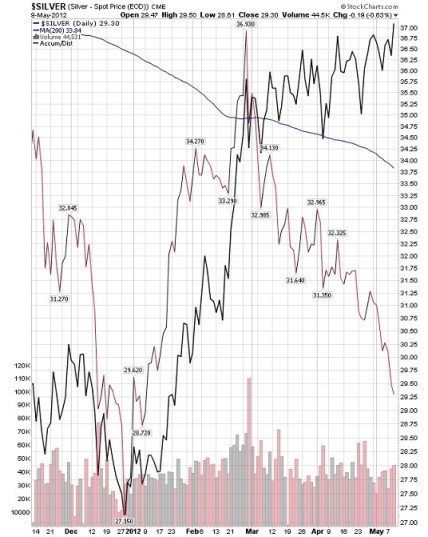
As the massive losses of JPM begin to show up, people are clamoring to arrive at conclusions about what is going on. I am not. This is not a shock to me and many others who have simply tried to understand the fundamentals of the present financial system.
The first thing my mind reverts to is something I’ve wondered a long time about: the JPM/Silver ratio. For a long time, I’ve noticed an interesting correlation of silver to the stock price of JPM. No, it doesn’t particularly matter that they both move around the 30-40 range lately. What matters is that, since JPM has a massive short position, suppressing the price of silver, the value of their stock must reflect the way they engage silver over the long term. They must take a loss if they are to dump their own money into bets that go wrong. When they do well in this short position, this too is reflected. I encourage you to look into this for yourself. It’s interesting, if nothing else. I wonder what a $2 billion flub will do to silver. I wonder what silver going through the roof last year was like for JPM. There’s a correlation there.
I also wonder about the nature of the ensuing cover up. This $2 billion blunder must certainly be the tip of the iceberg, as many have called it. And yet anyone who is familiar with the complex web of support between major banks and central banks knows that this kind of problem need not have instantaneous backlash if the right steps are taken to paper over the problem. It’s bad for reputation, but when a bank can borrow money for free, how much of this is just perception? How much will it really affect the ability of a bank to just continue doing what it’s doing? What seems certain is that nothing will really unravel until the paper money of major central banks is one day ignored for what it really is: an increasingly irrelevant form of manipulation.
Mostly, I simply realize that patience is all I need right now. I can’t tell you how many times I’ve grown tired with the panic-mode reaction of other people who are interested in silver and gold as a hedge against inflation. Instead of just dwelling on the low price of precious metals at the moment, think about this: do you think it’s just a coincidence that JPM has come forward with massive problems right in the middle of a sell-off in precious metals?
I don’t have all the answers. But I don’t need them right now. Things make plenty of sense if you step back from the moment. Volatility is simply the outcome of the psychological warfare that is taking place for the minds of the financial world. Common sense is prevailing, but it takes time. Normalcy bias seems like such an apt substitute for common sense to many people. But as people have their hopes dashed over and over, they will first be jaded, then cynical, then they will begin to look for alternative theories to explain what they thought they have taken for granted for so long. Then you will see a massive shift.
Unfortunately, when there’s a massive shift away from paper to precious metals, who will want to sell to those people? That’s a question worth thinking about. Undoubtedly, with the impending rise of precious metals, you will see massive shortages, and some people will be willing to part with their metal if only in order to survive. It won’t be a ‘trade’. It will be an exchange of necessities. So much ‘wealth’ we be erased.
So for now, do the right thing. Mostly, that means being patient.





